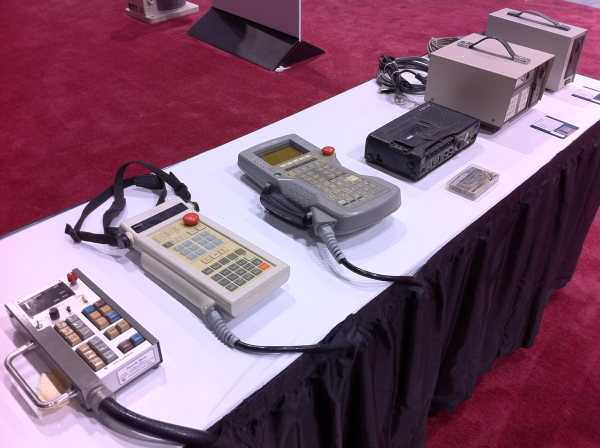The Evolution of the Robotic Teach Pendant


The teach pendant is the most common interface to program an industrial robot. The above picture was taken in the Tribute to 50 Years of Industrial Robotics at Automate 2011. I was impressed by how rudimentary the first pendants were compared to what they look like today. Even more impressive were the memory devices upon which the robot programs were recorded. Looking at the magnetic tape tells me that early roboticists must have been very patient people...
Still, the concept of the pendant remains the same today. For example, the big red button they all have has always been there. One thing that the early pendants had was simplicity. They have evolved to become almost a machine unto themselves - loaded with buttons and functions. I can imagine the stress they can cause a worker in manufacturing that needs to start programming a robot today without previous experience. And for very demanding tasks, some hardcore programming is still required.
What is the future of robot programming?
I cannot predict the future but let me throw out a few ideas.
- In the short term, we can easily envision changing the hardware to something more iPad-like. This would be a great advantage for manufacturers in the evolution of the pendant. They could more easily improve the software without having to think constantly about the hardware.
- A more graphical interface with less hardware buttons could also open the way to a lego mindstorm visual programming approach. If a 6-year old child can do it, a lot of people could also do it.
- As most products start with CADs, we can only see off-line programming such as what RobotMaster does grow in popularity and capacity.
- The new R15.06-201x Industrial Robots and Robot Systems Safety Requirements that should become effective later in 2011 might change the rules. In fact, there was also one demo at Automate where you could program a massive Kuka using a joystick directly mounted on the robot. The main idea of this standard is that a safe software controller will be sufficient to be in direct physical contact with the robot. You can thus expect in the future, more evolved take-you-by-the-hand teaching.
- Some mobile robots can already move around autonomously but they interact with the world using their embarqued manipulators at a very low level. They are far from autonomously doing mobile manipulation. Today, this still remains a challenge in robotics and will require improvements on how we can abstract manipulation tasks and how they can be learned.
- After this step, the ultimate programming will probably morph into autonomous learning by the robot using sensor information and experience, maybe even experience of other robots.
How do you think the robot programming will evolve?







Leave a comment